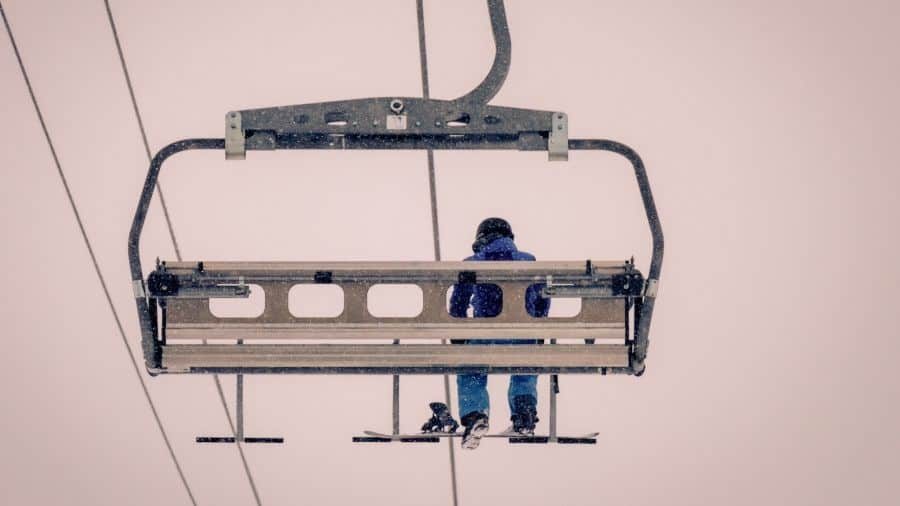
If you’ve booked your snowboarding holiday and checked the weather forecast and seen that it’s going to be raining, you might be wondering how these wet weather conditions are going to affect your plans.
You can still go snowboarding if it is raining. Slopes are often quieter and there will be fewer ques for the lifts. If temperatures are around freezing, snow becomes softer which allows for easier carving. It is important to wear the correct clothing to prevent getting cold and uncomfortably wet.
Snowboarding in the rain can be great fun, there are however a few important things to keep in mind. This post will share with you some of my own personal insights and useful tips to help get you through the day.
Table of Contents
Benefits Of Snowboarding In The Rain
Don’t let a rainy day dampen your spirits, if outside air temperatures aren’t too extreme, either too warm or way below freezing, this can be an awesome opportunity.
The best part is, when the heavens open, a large number of people will head for the exit and leave the slopes to get out of the rain.
You’ll have a lot more snow to yourself as the slopes begin to empty. Lift lines become non-existent and you’ll get to spend more time descending mountains and less time waiting for ski lifts. Some resorts have heated seats on their chairlifts, so you can sit back listen to the soft patter of the rain and take in the scenery all whilst being warmed up.
If you’ve booked yourself in for a snowboarding lesson, don’t be surprised if many people from your group don’t turn up. In this case, you’ll get a semi-private or even a private lesson without the extra cost.
If the outside air temperature is warm (slightly above and around freezing) then the snow will become softer, this allows for easier carving and overall fun mountain conditions to be out in.
If like me you take a GoPro with you, there’s something really satisfying about hearing the sound of the rain on your video especially when you play it back by the warmth of a fire.
Is Snowboarding In The Rain Safe?
Despite some of the benefits, there can be some hazards when snowboarding in the rain.
Snowboarding In Freezing Rain
If the temperature outside has dropped below freezing and its raining, this can cause icy surfaces that are difficult to snowboard on and can be potentially dangerous.
Snowboarding in freezing rain and on ice is not recommended for beginners as it becomes more difficult to maintain balance. Ice is very smooth and can be easy to slip on, hard-packed powder can also be slippery, although it’s a lot more forgiving than ice.
Snowboarding on icy surfaces with a thin layer of water on top can make it very hard to control and maneuver the snowboard as well as making stopping and carving extremely difficult.
Visibility can also become an issue when snowboarding in the freezing rain as goggles can frost over which will need to be scraped off. My advice for these extreme conditions would be to stay indoors with a hot cup of cocoa and wait until conditions improve.
Snowboarding When Its Warm & Raining
Warm outside air temperatures and rain can cause the snow to become heavy and slushy.
The combination of warm weather and rain will create less than optimum snowboarding conditions, making it harder to carve, and in general, everything you do will be more tiring.
An important factor to bear in mind when snowboarding in these types of conditions is fatigue. The extra weight of wet clothes combined with the extra exertion of snowboarding in heavy slushy snow can cause you to feel a lot more tired than you normally would.
Fatigue can lead to mistakes which in turn can cause accidents. Mentally and physically you will be more drained than usual, so use common sense and if you’re too tired, take a break or get some rest and just continue the next day.
Snowboarding In Wet Clothing
Wet clothing greatly increases heat loss through conduction and evaporation. And heat loss in cold, wet conditions increases the risk of hypothermia.
Hypothermia is when your body loses heat faster than it can produce heat and your body reaches a dangerously low temperature.
If you’re soaked from base layer to shell, spare yourself any further discomfort and get yourself into some warm dry clothes.
Tips For Snowboarding In The Rain
IF the conditions aren’t too extreme, don’t let a bit of rain stop you from getting out there and having an awesome time. Here are a few tips for snowboarding in wet weather conditions.
Wear Waterproof Clothing
Snowboarding clothing will come with a rating that will indicate how waterproof it is. The higher the number, the more intensive the rain can be before water will penetrate the fabric.
| Mm | Performance | Rain | Snow |
| <1500 | Shower Resistant | Light Drizzle | |
| 1500-5000 | Water Resistant | Light Rain | Dry Snow |
| 5000-10,000 | Waterproof | Moderate Rain | Normal Snow |
| 10,000-20,000 | Very Waterproof | Heavy Rain | Wet Snow |
If you know what weather conditions your likely to encounter, use the above table as a guide so you know what rating of clothing you’ll need.
As a general rule, if you expect to be snowboarding in the rain you should look at clothing with a rating around 10,000 mm. If you expect to be snowboarding in very heavy rain than look for a waterproof rating of at least 20,000 mm.
If you don’t want to splash out on brand new waterproof snowboarding gear then the good news is everyday rain gear will work as well.
If you have a set of waterproofs, you can wear it instead of your shell or just wear it over the top.
For those on a budget, a poncho will do the trick, however, it lacks the breathability that good quality jackets will provide so you might find yourself getting a bit sweaty. In light rain, a poncho will certainly get you through the day.
For the resourceful snowboarders out there, a garbage bag can be crafted into a makeshift poncho.
Wear A Helmet
Wearing a helmet has two great benefits, primarily it will protect your head, and secondly, it’s great for keeping your head dry. Unlike wooly hats that will absorb any moisture, helmets are 100% waterproof and the water will glide straight off.
I always recommend wearing a helmet if its raining or not, head injuries are no laughing matter.
Prioritize Drying Your Clothes and Boots
After you’ve finished for the day, the first thing you should do is get out of any wet clothes and put them somewhere where they can dry.
Some resorts will have designated drying cabinets or drying rooms, if you have access to these kinds of facilities then make the most of them.
If you don’t have access to such luxuries than crank up the heating and leave your wet gear to dry. If you have a fire, even better, just be careful not to put your clothes so close that they melt.
The best thing to do with wet boots is to remove the inner lining and put them somewhere warm, stuff the boots with paper towels or newspaper to absorb the moisture and speed up the drying process.
A great investment is a portable boot dryer or a hot boot bag which will ensure your boots, gloves are socks are nice and dry for the next day.
Bring Spare Gloves & Socks
Wet hands lead to cold fingers, so it’s important to bring a spare pair if you’re planning on snowboarding in wet weather conditions.
Even gloves with waterproof membranes won’t last a whole day so a useful tip is to bring a spare pair with you, either in your pocket or in a waterproof backpack. Alternatively, leave a pair somewhere warm so they’re nice and toasty for when you need them.
Always, always bring extra socks. Water and moisture can get into your boots and when it does it’s not particularly pleasant. However, changing over to a nice fresh pair of socks at lunchtime will certainly put a smile on your face and you’ll be all set to get back out there.
